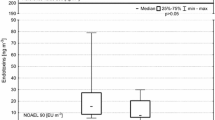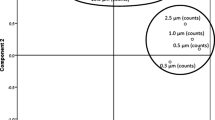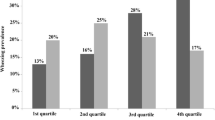Summary
Air-borne dust was collected on stationary and portable filters in two factories producing “biological” detergents. In one factory (“Factory A”) the detergent base was mixed with enzyme (subtilisin) powder, and the handling of the enzyme was done without effective protection. In the other factory (“Factory B”) the enzyme was encapsulated in “granules” before mixing the with detergent base, and the production line was shielded to prevent the spread of dust.
Both the amount of air-borne dust and the relative enzyme activity of the dust were greater in “Factory A” than in “Factory B” in spite of the considerably larger production of enzyme detergents in the latter factory. The workers studied in “Factory A” were, on the average, exposed to 5.4 GU (“glycine units”) per cubic millimetre in their breathing zones, and those studied in “Factory B” were exposed to enzyme activities about and below 1 GU/m3.
Based on exposure measurements and medical examination of the exposed workers, a time-weighted hygienic limit value for subtilisins of 1 GU/m3 is proposed.
Similar content being viewed by others
References
American Conference of Governmental Industrial Hygienists: Threshold limit values of airborne contaminants and intended changes adopted by ACGIH for 1970.
Documentation of the threshold limit value for the subtilisins. Revised Sept. 29, 1970.
Flindt, M. L. H.: Pulmonary disease due to inhalation of derivatives of Bacillus subtilis containing proteolytic enzyme. Lancet 1969 I, 1177–1181.
Göthe, C.-J., Nilzén, å., Holmgren, A., Szamosi, A., Werner, M., Wide, L.: Medical problems in the detergent industry caused by proteolytic enzymes from Bacillus subtilis. Acta allerg. (Kbh.) 27, 63–86 (1972).
Industry Committee on Enzymatic Washing Products: Recommended operating procedures for U.K. factories handling enzyme materials. Ann. occup. Hyg. 14, 71–87 (1971).
McMurrain, K. D.: Dermatologic and pulmonary responses in the manufacturing of detergent enzyme products. J. occup. Med. 12, 416–420 (1970).
Pepys, J., Hargreave, F. E., Longbottom, J. L., Faux, J.: Allergic reactions of the lungs to enzymes of Bacillus subtilis. Lancet 1969 I, 1181–1184.
Weenen, J. H.: Enzyme analysis: A rapid automated method. Proceedings of the 56th Annual Meeting 1969 of Chemical Specialities Manufacturers' Association, p. 109–112 (1969).
Weenen, J. H.: Personal communication (1971).
Author information
Authors and Affiliations
Rights and permissions
About this article
Cite this article
Göthe, C.J., Westlin, A. & Sundquist, S. Air-borne B. subtilis enzymes in the detergent industry. Int. Arch. Arbeitsmed 29, 201–208 (1972). https://doi.org/10.1007/BF00539248
Received:
Accepted:
Issue Date:
DOI: https://doi.org/10.1007/BF00539248




